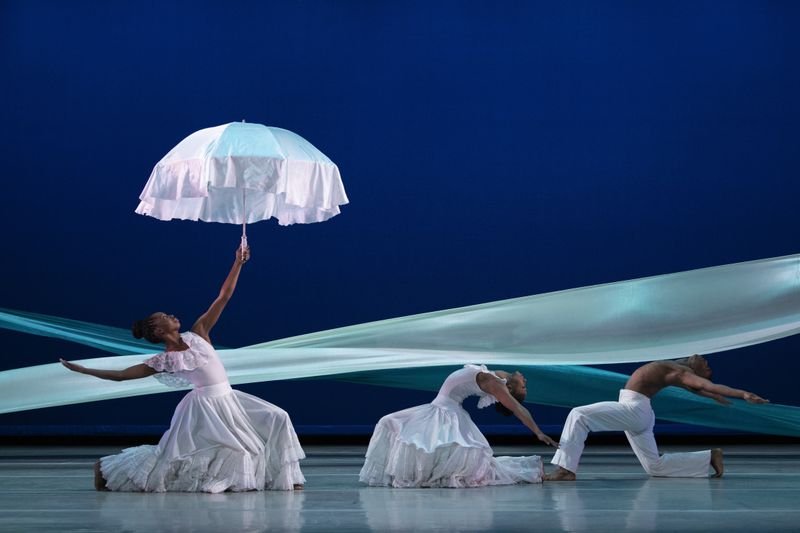Coming Full Circle with the Brilliance of the Alvin Ailey American Dance Theater
Experiencing Alvin Ailey dance company’s performances on March 1 at Overture Center evoked a whole range of emotions for me. The delicate beauty of the individual pieces was stunning. The feats of athleticism by some of the best dancers in the country were breathtaking. The combinations of vivid lighting, flowing, colorful costumes and masterful movement – sometimes frantic, sometimes elegant, sometimes robotic and stiff – was mesmerizing. But for me, the performance also felt like (dare I say it?) closure. An end to the COVID-19 pandemic’s complete shutdown of live performances.
The last time I saw the Alvin Ailey troupe perform, was also the last time I was in a theater for any kind of performance, for all of lockdown.
In March, 2020, I bought a pair of tickets to see the company to celebrate my best friend’s 50th birthday. The day of the show I made the 3 ½ hour trip to Iowa City, and we sat together in the glorious Hancher Auditorium on the campus of our alma mater, the University of Iowa. Along with 1,800 other theater-goers, we were fascinated by the artistry of the company, the inventiveness of the pieces, and the beautiful movements of the individual dancers.
The program ended with the company’s signature work “Revelations,” which simultaneously took my breath away and filled me with joy. But sitting in the second balcony of the grand auditorium, I kept sneaking glances at the audience in between pieces. As random members of the crowd covered coughs with their programs, I wondered with a sinking feeling if this would be the last such gathering for a while. Even though only a handful of COVID cases had been reported in Iowa and Wisconsin at the time, I was sadly correct.
Live theater has been struggling to come back, by fits and starts, for almost a year. With the recent surge and retreat of the omicron variant, thousands of optimistic ticket holders were disappointed once again as shows were canceled. Tentative attempts at national tours were halted due to illness. Things were rescheduled. Six weeks ago I was not confident that this performance would take place and if it did, I was even less comfortable with the idea of being so close to so many other people in an enclosed space.
But it did. And I was there to witness the exchange of energy and emotion that is only found in live performance. Not only that, but the exchange of greetings among the audience members who had been separated for so long. There were so many hellos and hugs and “great to see you”s, all around me on the main floor of the auditorium. At intermission, a member of the run crew came out to greet a gentleman seated right in front of me, gushing about how great it was to be back in Madison, just for one night, and wonderful to reconnect with friends in the dance world. It felt like a family reunion. Like a homecoming.
And there was no mistaking the crowd’s affection and appreciation for each of the smaller pieces that made up the first half of the program. Early in the evening audience members rose to their feet, whistling and cheering. And while taking their third round of bows, smiles crept up to the faces of the dancers, who could feel our enthusiasm reaching out to them onstage. That is something no video or movie can replicate.
In an evening full of highlights that celebrated the work of choreographer Robert Battle, we were welcomed back with a large, company number titled, “Mass,” which was inspired by a performance of Verdi’s “Requiem” at Carnegie Hall. Battle explained, “I found myself utterly absorbed in the intricacies of how the choir moved as a unit and then organized and condensed themselves in the pews. The juxtaposition of the choir themselves constrained by space while their voices traveled through the hall was fascinating. I began creating the movement by deconstructing the chorus.” Indeed, the golden sheen of the costumes interacted playfully with shafts of light as dancers moved in tiny steps around the stage, with the intention and precision of a clock, or large machine.
In “For Four,” a quartet of Ailey dancers celebrated Wynton Marsalis’s jazz score as they moved through distinctive decades of 20th century dance styles. Originally created as the opening video segment for the company’s virtual broadcast of its 2021 gala, Battle reportedly used his frustration and pent up energy that accumulated during the COVID-19 pandemic as inspiration for the piece.
And in “Takdeme,” dancer Kanji Segawa let the staccato syllables of Sheila Chandra’s a cappella tone poem “Speaking in Tongues II” ripple through his body. As if he was plugged into an electrical current that was synchronized with the playful, often surprising sounds and rhythms of the unconventional music piece, Segawa literally let the music move him. An amazing physical display with a side of whimsy, it was a masterful piece that ended too soon.
After the intermission, the company performed its signature work, “Revelations.” Celebrating Black lives, work, religion, and music, from enslavement through the mid-20th century in America, it is one of the most thrilling works in modern dance, and has been part of the company’s repertory for more than 50 years. It is also a testament to Alvin Ailey’s vision for dance that explored the unique history and stories of Black culture. Often characterized as a journey from despair to joy, it is impossible not to feel uplifted at the end of the 30-minute series of pieces.
This jubilance is why we gather for live performances, and as the feeling followed me out to my car and the ride home, I felt a lightness that was unfamiliar over the past two years. I hope that we can all return to the theater over and over in the weeks and years to come to experience it again.





